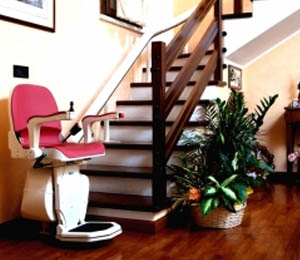Seated Stair lifts
As you get older you need help with more and more things and eventually there could be the need to have help getting up and down stairs. As well as aches and pains there may be problems with balance and it will be best not to try and do this alone. If you would prefer not to have to move downstairs it will be worth finding out if you would benefit from a stair lift.
Seated stair lifts are the most popular type fitted, and these make it safer as there is no worry about losing balance and falling. There are some concerns as they are not suitable for everyone, but by finding out about the different types you should find one that is going to make life easier for you.
There are a number of things to remember before having a seat fitted and that is the ability to move around on the flat regardless of whether or not you can climb stairs. There is no point having a chair fitted if you are in a wheelchair and either do not have the room to get the chair close to the stair lift, or are not able to get out of the chair and onto the stair lift. In the same way there is the issue about what you do once you are up at the top of the stairs. Are you able to get out of the chair safely and are you then able to get into the bathroom or bedroom?
It is important to be able to bend your knees or there will be no point having a seated stair lift fitted. It is also worth considering if this is the long term solution as a seated stair lift is not always the best as health may deteriorate.
A lot of the machinery can be mechanically operated but it is always advisable for the person using the lift to be able to move on and off themselves. Standing up at the top of the stairs is probably the most dangerous part of the manoeuver and if there is any doubt about the ability of this to be done alone, the lift should not be used without help.
Back to Top
Types of Seated Stair Lift
It is possible to have a lift fitted to straight or curved chairs. The only problem with some stair cases is the width. In some houses there are very narrow stairs and there is not enough room for a chair to be fitted as well as allowing someone to sit on it and get up and down. A straight one is much easier to fit and also takes less time to get you up and down. The curved one is much harder to fit and needs to be measured exactly to each staircase.There are a number of things to remember before having a seat fitted and that is the ability to move around on the flat regardless of whether or not you can climb stairs. There is no point having a chair fitted if you are in a wheelchair and either do not have the room to get the chair close to the stair lift, or are not able to get out of the chair and onto the stair lift. In the same way there is the issue about what you do once you are up at the top of the stairs. Are you able to get out of the chair safely and are you then able to get into the bathroom or bedroom?
It is important to be able to bend your knees or there will be no point having a seated stair lift fitted. It is also worth considering if this is the long term solution as a seated stair lift is not always the best as health may deteriorate.
Using the Seated Stair Lift
The person using the stair lift will also have to be able to use the controls that move the lift up and down. It will be possible to carry an item such as a walking stick on the lift, but larger items such as a walking frame or wheelchair will have to be duplicated so as there is one upstairs and downstairs.A lot of the machinery can be mechanically operated but it is always advisable for the person using the lift to be able to move on and off themselves. Standing up at the top of the stairs is probably the most dangerous part of the manoeuver and if there is any doubt about the ability of this to be done alone, the lift should not be used without help.
Back to Top

